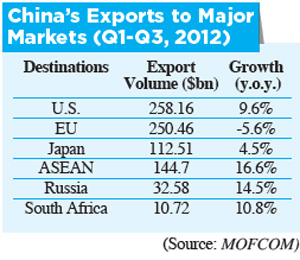|
Outside China, as various countries strengthen their macroeconomic policies, the European debt crisis is mitigated and the U.S. economic recovery becomes stable, the global economic environment may improve.
However, the sovereign debt crisis in developed economies undermines the potential for growth, and the side effects of stimulus policies have become increasingly prominent. Emerging economies face various difficulties and trade and investment protectionism is intensifying. Therefore, low global economic growth will continue.
Within China, as a series of policies and measures for expanding domestic demand and stabilizing external demand are implemented and produce effects, China's economy has become stable.
However, the basis for stable economic growth is not solid and domestic consumption is still subject to restrictions from systemic factors. Some industries are confronted with excess production capacity and businesses still face various other difficulties.
The report says that unfavorable conditions at home and abroad will continue, and export orders will slump in 2013.
The decade starting in 2002 saw the fastest foreign trade growth, with an average annual growth rate of more than 20 percent.
In 2011, China's exports accounted for 10.4 percent of the world's total, ranking first for three consecutive years; imports accounted for 9.5 percent of the world's total, ranking second for three consecutive years.
With profound changes both at home and abroad, the rapid growth of foreign trade in previous years in China will be difficult to sustain, the report says.
Dawn out of darkness
Although foreign trade is confronted with a harsh reality, Wang Shouwen, Director of the Department of Foreign Trade of the MOFCOM, said that moves to diversify markets for the country's exports are producing a desirable effect.
Wang said in the first half this year, the four traditional markets for the Chinese mainland—Europe, the United States, Japan and Hong Kong—accounted for 56.5 percent of China's total exports, much lower than its peak of 80 percent, indicating that efforts to diversify China's export markets are seeing success.
Furthermore, exports are being better distributed across the country. The coastal areas contributed 88.5 percent to the country's total exports compared to 96 percent in 2010.
Also, the processing industry used to account for more than half of the total trade volume, but now the proportion has dropped to 42 percent.
Five years ago, China put forward a development strategy for restructuring the economy, aiming to shift its economy from one dependent on exports to one driven by consumption.
Yao Jian, spokesman of the MOFCOM, said the most prominent change to China's foreign trade in 2012 was that general trade grew more rapidly than the processing industry, which indicates that China is relying less on processing fees.
The MOFCOM figures show that in the first three quarters, China's general trade grew by 5.9 percent over a year ago. Of the total, exports rose by 8.3 percent and imports by 3.6 percent, which were respectively 5.3 percentage points and 2.6 percentage points higher than those of the processing industry.
Another point of interest is that while exports to traditional destinations decline, China's exports to emerging markets are growing rapidly. For example, exports to the Association of Southeast Asian Nations and Russia increased by 16.6 percent and 14.5 percent respectively.
Third, exports of independent brands account for a larger proportion. Among all exporting enterprises, 20 percent have independent brands.
Yao said in the future, China will face greater pressure to shift its economy because costs have risen rapidly in recent years, weakening the competitiveness of China's manufacturing industries to some extent.
From 2008 to 2011, the per-capita annual salary for urban manufacturing employees grew at an average annual rate of 14.5 percent and that of migrant workers in manufacturing industries grew by 15 percent. As industrialization in neighboring countries accelerates, some enterprises are shifting operations elsewhere.
In the first seven months of this year, the market share of China's seven categories of traditional labor-intensive products exported to the United States, Europe and Japan declined by 2.1 percentage points, 1.4 percentage points and 2.7 percentage points respectively. Most of the lost shares were squeezed by China's neighboring low-cost countries.
"When external demand declines, China's labor-intensive products are facing growing international competition," said Yao. "Therefore export-oriented enterprises should shift to high-end manufacturing and focus on enhancing product quality."

Email us at: lanxinzhen@bjreview.com | 